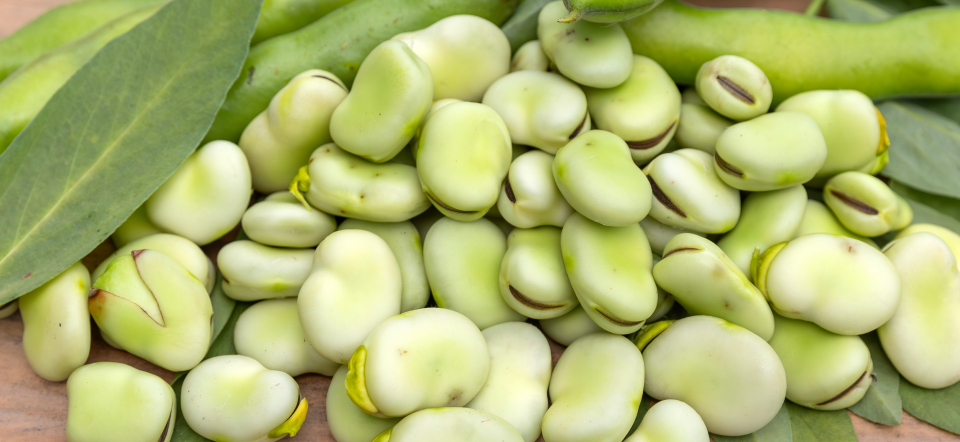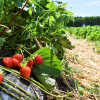Can one bean be the future of food security in the Nordic and Baltic region?
If you ask Professor Fred Stoddard from the University of Helsinki, the answer is yes. Stoddard has been researching the faba bean – which he calls his “pet crop” – since the 1980s. Now he is the coordinator of the research project Climate-ready faba beans for the Nordic and Baltic Region (FabaNova). The project aims to increase the stress resistance of faba beans to improve yield in the Nordic climate.
Facts about the Faba Bean (Vicia faba)
- Faba bean, also known as fava bean or broad bean is a grain legume.
- It is one of the oldest cultivated bean crops. It was taken into use 10.000 years ago in the Fertile Crescent.
- It is very effective at nitrogen fixation. It fixes about 80% of its nitrogen needs from the air.
- It provides energy from starch and protein nutrition and is suited for consumption by both livestock and humans.
- It contains 45% starch and 29% protein on a global average. In the Nordics the protein content is generally even higher.
- It is good for crop rotation and so-called legume breaks improve soil microbiology.
“We need to produce more of our own plant protein for both feed and food uses in the Nordic and Baltic region to ensure better protein self-sufficiency. In fact, we need that in all of Europe, but especially here in the North, because we currently import lots of soy. And in addition to all the questions about land use change in the Americas, we also have to compete in the international market with China, which now buys three times as much soy from the Americas as all of Europe. So, we need to look after ourselves for all kinds of reasons, and plant protein is, as we believe, best produced by grain legumes”, says Stoddard.
Legume crops have the advantage that they biologically fix nitrogen from the atmosphere. They also have a lot of protein packed into their seeds and they can grow during the short growing season in the north. Of the two grain legumes that grow in the region – faba beans and peas – faba beans have a higher protein content: 29 per cent on average globally, compared to 24 per cent in peas.
“Young people in particular want to have a more sustainable less meat-based diet. I am happy to hear from my colleagues in food science about all that is happening in the development of dairy, meat and egg substitutes. I think the future is in food rather than feed. The problem is that farmers in the region are not used to growing legumes. They mostly grow small grain cereals, such as wheat, barley, oat and rye”, says Stoddard.
According to him, faba beans have the potential to deliver what the region needs in terms of food self-sufficiency and environmental sustainability, if we learn how to grow them properly. In Finland, for example, the average faba bean yield for the last seven years has been one and a half tons per hectare, which is a third of what some farmers achieve elsewhere. The FabaNova project tries to tackle three problems that hinder the faba bean yields from reaching their potential in the Nordic and Baltic region.
“The most severe biotic stress factor for faba beans is a fungal disease called chocolate spot disease. Drought is the abiotic stress factor that most affects faba beans. Most of the crop loss is due to drought. We have spring droughts in many parts of our region, and often summer droughts as well, and faba beans are more sensitive to drought than, for example, field peas.”
New insights into chocolate spot
The project has already been able to find some new information about the cause of chocolate spot disease.
“Previously, it was thought that chocolate spot disease was only caused by a fungus called Botrytis fabae. Later, some evidence was found that another Botrytis species, Botrytis cinerea also caused the disease. In the last 15 years, two more Botrytis fungi have been isolated from faba bean leaves. So now we have a cluster of four species that we think are involved in the spread of the disease. By collecting diseased leaves from fields in all of our four countries, Norway, Sweden, Finland and Estonia, we can already confirm that all four species exist, and we also have evidence of still other undefined species”, Stoddard tells.
Now the aim is to test the genetics of resistance to these different species that cause chocolate spot. A population of faba beans has been inbred by crossing two parents that differed in disease resistance. This faba bean population has already been tested for its resistance to Botrytis fabae in Canada.
“We have now tested this population to all four fungi species using detached leaves and are very excited about the results because it looks like the mechanisms of response to these four species are related, even though balanced a bit differently. This is last month's result and we're still trying to figure out what it all means, but it seems the population has resistance to all species”, Fred Stoddard says.

Even though there are several fungi species causing chocolate spots in faba bean, they can all be tackled with the same fungicide. The project is also developing a forecasting system that can alert farmers when conditions are favourable for disease outbreaks.
“The disease thrives in a narrow range of temperatures and humidity. With the model we can tell farmers specifically when they need to use fungicides, so they don’t lose their crop. The model development is a nice example of Nordic collaboration. We have a fabulous data set from Sweden covering over 20 years and the ability in Norway to extract the data from that and manipulate it to see what the conditions are such that the disease will break out in fact rather than in theory”, says Stoddard.
Drought and earliness
In Norway and Estonia drought resilience is tested through experiments in rain exclusion shelters. The aim is to find which drought responses work best in practice in the field and to use this information in breeding. As the experiments are just starting there are no concrete results yet, but Stoddard encourages farmers to see the potential of better water use.
“A small experiment I did last year shows that the yield from fields unaffected by draught is 2.8 times that of the dry ones and the Estonians did a slightly larger experiment where the yield was threefold better on the damp plot. So, we're getting a nice body of data to show farmers that it's time to start thinking seriously about better water management. With climate change, the predictions are that the total rainfall in the summer will be the same as now. But the rain will come all at once and then two months of drought and then all at once again. That's what we've seen at least in Finland in recent years and I understand the situation is similar in the rest of the region.”
The faba bean is the first crop to be sown and the last crop to be harvested in the region. Typically, it has a growing season of about three and a half months. In contrast, a pea crop or a barley crop can be harvested in a about three months. To better understand the earliness problem of faba beans, the project’s Swedish partners have set up experiments at three latitudes in Sweden and Estonia. Here, they are analysing how 15 faba bean cultivars from different parts of the world respond to variations in day length and temperature.
“From that data set, we hope to dissect day length response, if there is any, from temperature response throughout the growth of the plant. The information from the experiments could be used in conventional breeding or accelerated breeding or even gene editing, to create faba bean cultivars best suitable for the northern climate”, explains Stoddard.




